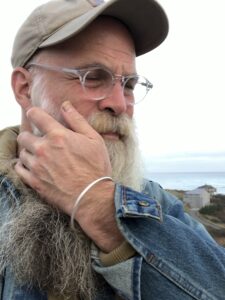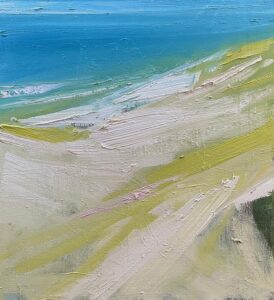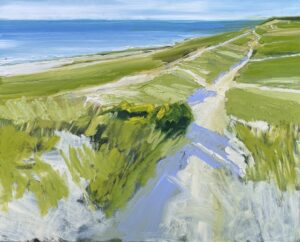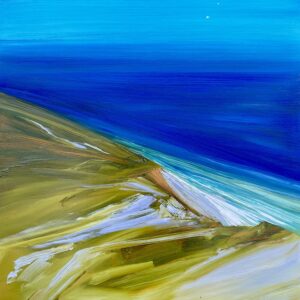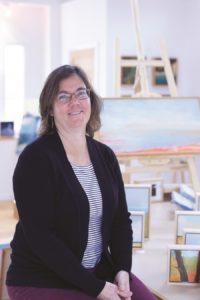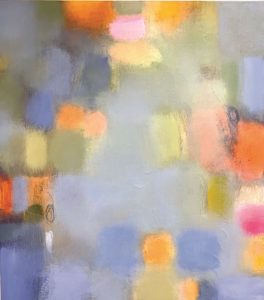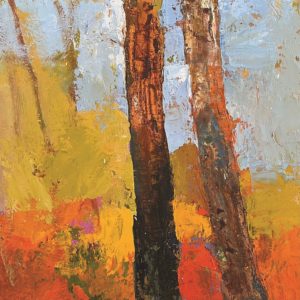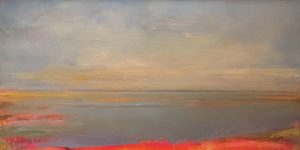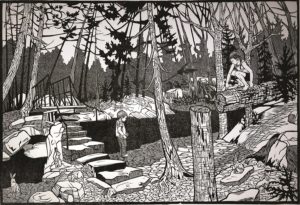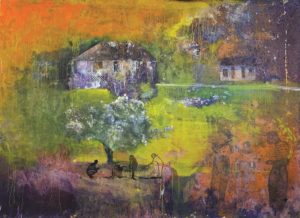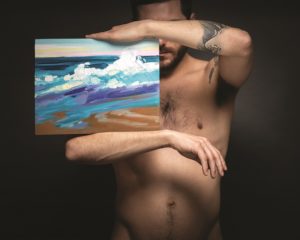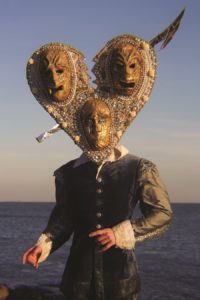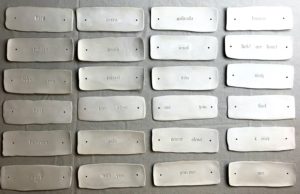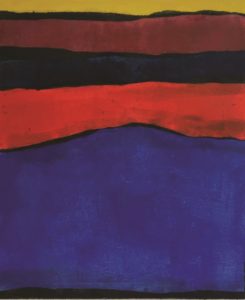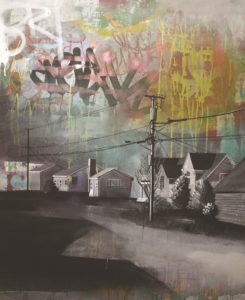AMZehnder Gallery (25 Bank St. #3)
At the AMZehnder Gallery, Mia Cross’s exhibition “Patchwork” is up. Her large-scale oil on canvas works are done in celestial blues and burnt reds; women sew stars into a night sky, a checkerboard “ZebraHorse” stands under a fingernail moon.
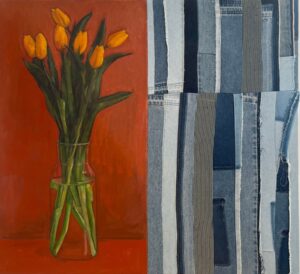
Jill Mays of Truro is interested in Stems, a mixed-media piece. A vase of orange tulips occupies half of the canvas. The other half is strips of denim. “I love the combination of the oil and the texture of the fabrics,” Mays says. And maybe jeans are on her mind — “I just ordered a pair on sale this morning.”
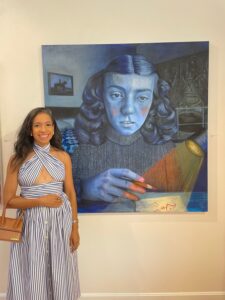
Mays’s daughter-in-law, Boston lawyer Yari Sanchez, likes First Love on the Cul-de-sac. The piece depicts “a little girl who probably has a crush on somebody,” Sanchez says. The work is done in “bluescale,” she says, but other colors appear in key places: the red and yellow lamplight illuminating the girl’s romantic doodles, the pink blush on her cheeks. “It’s nostalgic,” Sanchez says. “Her eyes are communicating that innocent love, that longing.”
Cove Gallery (15 Commercial St.)
The Cove Gallery is bustling with activity. Despite the crowd, New York City special education teacher Olivia Horenberger has found a sense of calm in Larry Horowitz’s Before Dawn. The oil on linen piece hangs high up above a doorframe. From the lower right corner to the top left, the work transitions from a deep black landscape to a bright rainbow sky.

“At first, I really felt that it was the sunrise,” Horenberger says. Title notwithstanding, “the longer I looked at it, I felt it could also be a sunset, with the very last bits of the Sun peeking through.”
The piece can be both, she decides; the sky can settle or invigorate the viewer, depending on one’s perspective. Ultimately, the dark black of the land and the luminescent sky work together, Horenberger says. “It’s all one deep breath.”
Farm Projects (355 Main St.)
Deborah and Michael DeWan, who live in Wellfleet and Woodstock, N.Y., are mesmerized by John O’Connor’s colorful Sophia and Jackson, a big piece at 60 by 48 inches. The words tell the story of the lives of two people, beginning with their births and ending with a tragic death. O’Connor’s words and sentences overlap, cut each other off, and combine in strange and sometimes nonsensical ways.

“I’m drawn to the way their lives are parallel but not really,” Michael says. “It’s quite remarkable that you can cross-read some of the elements and not be sure whose life he’s talking about.”
Deborah has just finished reading through the piece. “It’s pretty extraordinary storytelling,” she says. “It’s complex and emotional. But it’s also so matter-of-fact.”
She considers the work again, tilting her head. “You can put into it whatever you like,” she says. “That’s one of the experiences I’m having with his work. On one hand, it’s distant; on the other hand, it draws you in.”
Jeff Soderbergh Gallery (11B West Main St.)
On this night, Ellee Koss has been taken in by “the embodiment of light,” she says. From the top floor of Jeff Soderbergh Gallery, she leads the way downstairs to a hanging piece by Bernhard Dessecker: Floating Gold Pine, a thin, gold-plated branch of pine containing an LED strip light.
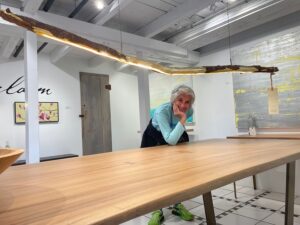
Koss, a semi-retired photographer and author, has a house in South Wellfleet and also spends time in San Francisco and Ecuador. She sets the scene: “Imagine that you’re sitting here in the dark,” she says. “Then you’ve got this beam of light coming through this gorgeous log.”
She inspects the piece from all angles. “I’m not as excited about the gold,” Koss decides. “I’d prefer it without.” But she’s not rigid — she recalls a smaller Dessecker lighting piece upstairs. “On that one, the gold really works.”
The Works Gallery (55 Commercial St.)
Jacob Pentz, a recent graduate of Colorado College, has come from Sudbury to be here for the weekend. In the Works Gallery, he carefully observes Diamonds on the Bay by Paul Suggs.
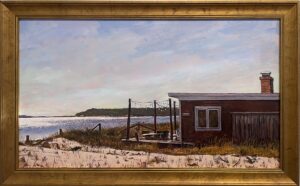
“I like how defined it is,” he says. “The detail is amazing.” The piece, done in acrylic, shows an old house on the beach under a pale sky. The colors are muted but crisp — every shadow is deep, every speck of light gleams. “The colors are really well done,” says Pentz. “The highlights on the water and the details of the grass. There’s a lot of contrast.”
When he looks at the piece, he feels serenity, and he sees a story. “I’m picturing a house that’s been weathered by storms,” Pentz says. “It’s a house with history, but it’s still very lively. The family that lives there has put up string lights.” The place is quiet but not lonely. “People still come back to it,” he says.
